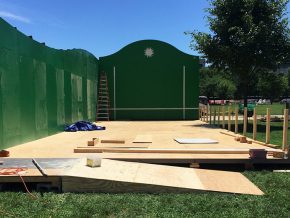The Folklife Frontoia: Building a Community Center

Nothing about construction on the National Mall is straightforward. There are the inevitable complications and unanticipated challenges that crop up any time design meets fabrication, but the rules and conditions we deal with on the Mall complicate things further. The Frontoia we built for the Basque program was no exception.
From the (un)levels of the ground to the electricity setup to the weather, we constantly readjust, rethink, and modify to make it work. We solved a lot of problems on this project, learning so much about design and process as we went. It’s a running joke that “our next frontoia is going to be even better!” Our tech crew members are now looking for post-Festival work as traveling frontoia-builders…
The frontoia, we were told early on by our technical director Tyler Nelson, was a pilota (handball) court where people also sometimes got married and shared meals. It was a bit difficult to imagine. It was a very important part of Basque communities—a true multipurpose gathering place—he said, and it would be our primary large structure for this year’s Folklife Festival.

It would be a mix of steel and wood—not the cinder block walls that a real frontoia in the Basque country would use—and it would be much smaller than regulation-size courts. Those were our earliest modifications: size and materials. We have to work within the bounds set by the National Park Service and accept the tight timelines and temporary nature of our work. A sprawling cinder block structure simply wasn’t possible, but we would do our best to be authentic to the spirit and practicality of the Frontoia.
Tyler had visited real frontoia structures on his research trip to the Basque region, and he felt confident we could pull it off. We looked at photos in his office. The AutoCAD drawings were impressive, too, showing a very clever multi-use space. He had incorporated a dirt bowling alley and an area that would demonstrate the salt making process while adding about 52,000 pounds of ballast. Tyler had a lot of variables to consider as he designed, from cultural authenticity, to construction practicalities, to the requirements of Smithsonian engineers. Our Frontoia, temporary though it may be, had to be able to withstand 90 mph winds and take a lot of weight.


We began building the Frontoia’s steel skeleton in our warehouse in April. Its base, which is roughly 24 feet by 8 feet, was carefully designed to be able to fit out the loading dock door. It had about an inch-and-a-half clearance, and it was quite a production to get that unwieldy, 2,500-pound monster out the door and onto a flatbed truck for delivery to the Mall, but we did it!
I should probably clarify here that I am a dry-stone waller who does a bit of welding and dabbles—pretty badly—in carpentry. My personal learning curve on this project was a very steep one! For starters, I don’t normally deal with drawings apart from things I sketch roughly for clients, let alone operate boom lifts, swagger around in a harness, battle cranky generators, and wrangle a full menagerie of power tools. Luckily, I work with theatre carpenters, painters, riggers, machinists, and heavy equipment operators who can build just about anything, and in a hurry. Together, we are much smarter and much more creative. Slowly but surely, the Frontoia came together over the course of several weeks.
The night we finally raised and secured the hinged walls that comprise the primary playing surface—the most nerve-wracking part for me—I knew we had succeeded. It looked like a real pilota court. The most gratifying moment, though, was watching the Basque advance team play an impromptu game of pilota the morning of our opening ceremony. I was still working on the fringes, but the guys were laughing and whacking the ball all over the place. They teased me, “It’s time for play, not for work!” I couldn’t have agreed more. But the real message was that it was an inviting space for them—it was good enough. They liked it. We’d done it. It only got better from there.




By the first hour of the Festival’s opening day, I was crying privately behind my dark-tinted safety glasses every time I passed the Frontoia. I was exhausted, so I was relieved that it was over, but I also felt overjoyed at its use, at everyone’s enthusiasm. Finally, it was filled with happy people, music, and dancing—not just pilota. For some reason, I had only thought about sports as we were building. No, this was to be the heart of the Basque community on our Mall as well as it its villages.
I had been so caught up in the details—hardware, last-minute jig saw modifications, clamps, ratchet straps, 30-inch stakes, faux Spanish tile—that I had sort of forgotten the point. The Frontoia finally came to life when the Basques took it over, and suddenly it all felt worth it.

Whitney Brown is the Folklife Festival carpenter, as well as a dry-stone waller and folklorist.

